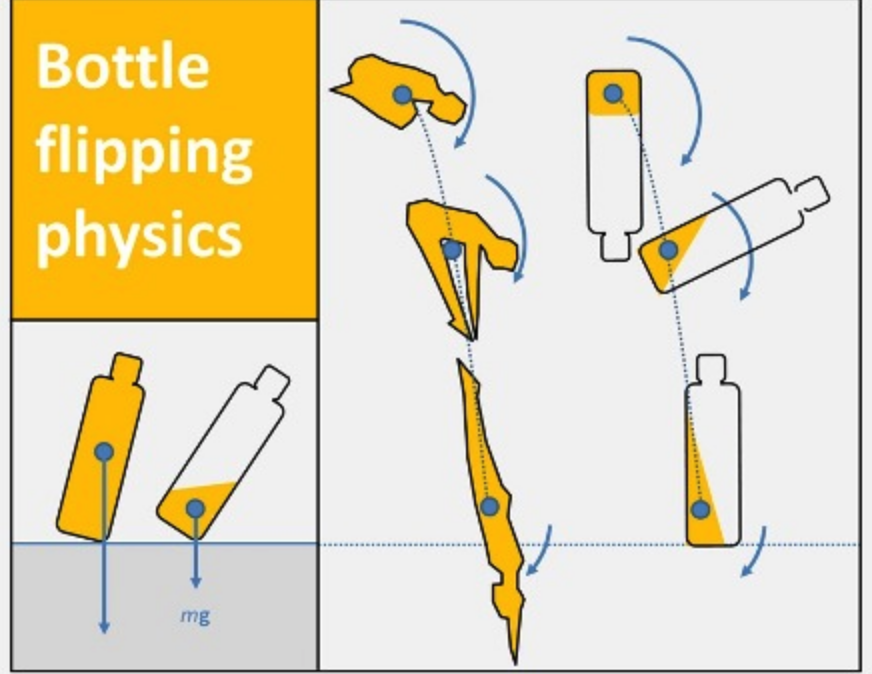Gravity and Bottle Flipping
Lesson Summary
Students love "bottle flipping," tossing water bottles with skill to make them land on the cap end. Some students consider themselves experts at bottle flipping, and practice endlessly the hand techniques and nuance necessary to nail the flip! This lesson weaves mass, motion, gravity, predictions, and observational practice into a fun lesson that can be extended at home.
Objective:
The objective of this lesson is to provide students with an opportunity to practice phrasing scientific inquiry, observation, experimentation, data gathering, and creating a hypothesis.
Rationale:
This activity is designed to incorporate student interest in "bottle flipping" and using the activity to demonstrate the scientific principals of gravity, center of gravity and mass. Students can explore these concepts using the Scientific Method, making predictions about which bottle they can flip most successfully. Finally, by recording data of successful bottle flips, students can compare the different substances and draw conclusions on why a particular substance had more successful flips.
Material
Note that materials listed are optimally for 1 (one) group of 3 (three) students. Multiply accordingly.
- 16 ounce water bottles and caps (3 bottles per group of three students) empty and dry inside. See Preparation b
- 1 cup of sand per bottle
- 1 cup of fish tank gravel per bottle
- 1 cup of tap water (food coloring added, for fun) per bottle
- glue
- masking tape
- marker
- data sheet
- pencils
* It is helpful to let the bottles sit for a few days to dry out. Dry interiors are best for the sand and gravel bottles.
* Groups of 3 students works best with this activity. Adapt as necessary.
Preparation:
Before the activity, prepare a set of bottles as follows:
1. Pour 1 cup of sand into a bottle.
2. Pour 1 cup of fish gravel into a bottle.
3. Pour 1 cup of water into a bottle. Add food coloring if you want for fun.
If desired label the bottles with masking tape to identify the contents.
4. Dab a bit of glue to the lids and seal the bottles securely. Wait a day or two for the glue to set; bottles should now be watertight and unable to be opened.
You should now have 3 bottles filled each with one cup of substance; one each water, fish gravel, and sand. Repeat this steps for as many groups as you need. Remember the ratio is 3 students / 3 bottles / 1 bottle of each substance.
Procedure
1. Group students. Groups of three students work best.
2. Pass out data sheets and 1 set of bottles. Each group should have one bottle of each substance (3 bottles total).
3. Assign jobs. Students should take turns with the following jobs: flipper, Counter #1 (number of flips), and Counter #2 (number of successful "capping" flips - when the bottle lands on its cap).
3. PREDICTION: Ask students to complete the PREDICTION on the data sheet. What bottle do they think will have the most frequent successful flips? Ask students to brainstorm in their group. At your discretion students can combine ideas into one prediction, or make individual predictions. Predictions should be recorded.
4. Begin flipping bottles. Start with the water bottle. The "Flipper" should take turns flipping the water bottle. The Counter #1 should make tally marks to the total number of flips attempted; count every flip no matter the outcome. count each flip. Counter #2 counts ONLY the number of successful capping flips.
CAUTION: Monitor bottles closely to ensure they are securely closed.
NOTE: Flipping bottles onto a floor or table works best.
5. Students should record data on the sheet.
6. Students can flip bottles for 1 minute per substance.
7. Rotate through substances, and student jobs. Each student should get a turn flipping a substance. If time permits, rotate a second time so students can attempt flipping all three substances.
8. When all three substances have been flipped for one full minute, and the data recorded, students should share out their results. Students can then discuss the results. Students should answer the questions:
- What was the total number of all flips?
- What was the total number of "capped" flips?
- What substance had the most "capped" flips? Can you express this in a rate?
- Using what you know, explain why one substance had more successful flips than the others.
As an extension, you can create a data sheet that allows students to calculate percentages to give a statistical representation of the activity.
10. A capstone lesson on mass, motion, gravity, or the scientific method should follow.

The Physics of Bottle Flipping.